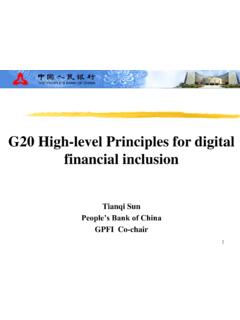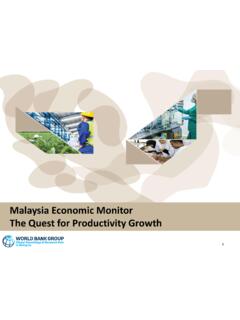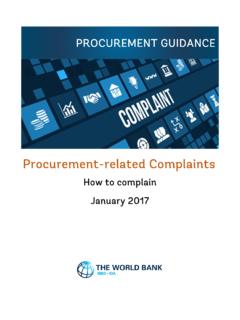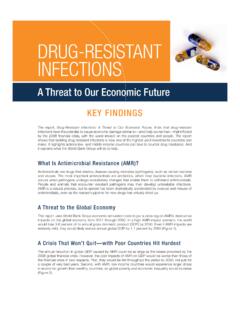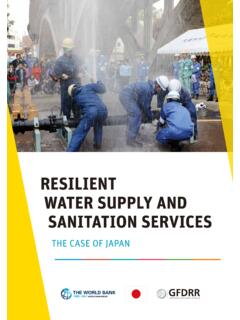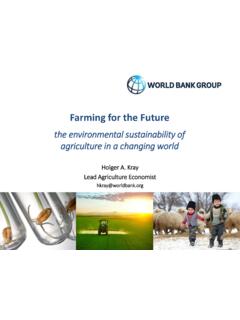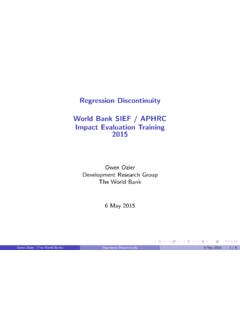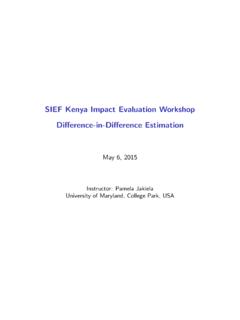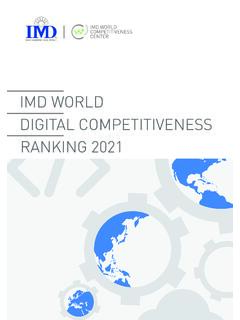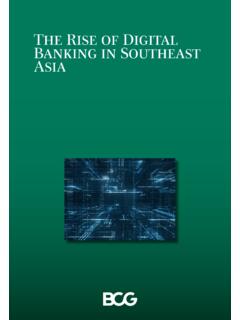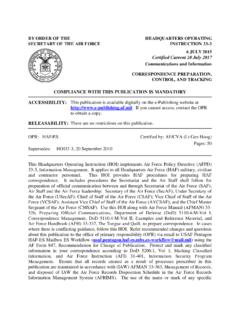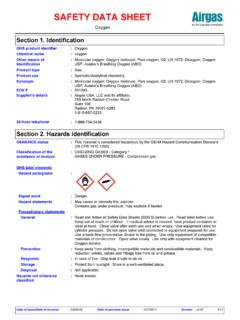Transcription of DIGITAL FINANCIAL SERVICES - World Bank
1 DIGITAL FINANCIAL SERVICES April 2020 Ceyla Pazarbasioglu, Alfonso Garcia Mora, Mahesh Uttamchandani, Harish Natarajan, Erik Feyen, and Mathew Saal Foreword Access to affordable FINANCIAL SERVICES is critical for poverty reduction and economic growth. Countries with deeper, more developed FINANCIAL systems have higher economic growth and larger reductions in poverty and income inequality. For poor people, access to and use of basic FINANCIAL SERVICES can improve incomes, increase resilience and improve their lives. Women especially benefit. Far too many people 65 percent of adults in the developing World lack access to even the most basic transaction account that would allow them to send and receive payments safely and easily, much less the savings, insurance, and credit SERVICES that would help them expand their businesses, mitigate risks and plan for their futures.
2 DIGITAL FINANCIAL SERVICES , powered by fintech, have the potential to lower costs by maximizing economies of scale, to increase the speed, security and transparency of transactions and to allow for more tailored FINANCIAL SERVICES that serve the poor. This report describes the tools of DIGITAL finance, the successful business models and policies for encouraging their growth. It explores risks and challenges of new types of SERVICES and the legal and regulatory frameworks needed for confronting them. Finally, it includes country experiences with promoting the expansion of DIGITAL FINANCIAL SERVICES and the obstacles along the way. The current COVID-19 pandemic has amplified the urgency of utilizing fintech to keep FINANCIAL systems functioning and keep people safe during this time of social distancing, falling demand, reduced input supply, tightening of credit conditions and rising uncertainty. At the same time, these new technologies must be designed and implemented carefully to manage their risks, particularly for the poor and vulnerable, so as not to exacerbate the challenges posed by this crisis.
3 There is also an urgent need for investment in the prerequisites for developing DIGITAL FINANCIAL SERVICES , such mobile broadband infrastructure including in remote areas expansion of DIGITAL identification, and open application programming interfaces. These investments should be complemented with the relevant legal and regulatory frameworks that can allow most people to benefit from DIGITAL FINANCIAL SERVICES and ensure a competitive ecosystem. Fintech is helping governments quickly and securely reach people with cash transfers and other forms of FINANCIAL assistance and reach businesses with emergency liquidity. It is allowing people to transfer funds including cross-border remittances and to pay bills from their home, or in a market or store setting, with limited physical contact. But the potential is much larger than what has been achieved. This crisis has highlighted the benefits of DIGITAL FINANCIAL SERVICES in many different dimensions and its critical role in achieving the Sustainable Development Goals.
4 In this way, increasing usage of DIGITAL FINANCIAL SERVICES can hasten resolution of the health emergency, support economic recovery and underpin the return to economic growth. Over the longer-term, it will contribute to economic development and ending poverty. We hope this report will provide valuable insights for policymakers and for FINANCIAL sector players seeking to expedite FINANCIAL inclusion and development of DIGITAL FINANCIAL SERVICES . Respectfully, Ceyla Pazarbasioglu Vice President Equitable Growth, Finance and Institutions, The World Bank Group Acknowledgements This publication was produced by a World Bank Group team led by Ceyla Pazarbasioglu, Alfonso Garcia Mora, Mahesh Uttamchandani, Harish Natarajan, Erik Feyen and Mathew Saal. This publication benefitted from inputs provided by several colleagues from the Finance, Competitiveness and Innovation Global Practice (FCI GP) of the World Bank Group, CGAP and IFC, including Oya Pinar Ardic Alper, Margaret J.
5 Miller, Georgina Marin Espinosa, Edoardo Totolo, Delia Buisi Dean, Greta Bull, Gregory Chen, Leora Klapper, Jake Hess. The team would like to thank Stephanie von Friedeburg, Paulo de Bolle and Hania Dawood for their valuable comments during the review process. Natanee Thawesaengskulthai and Elizabeth Price provided invaluable support in the process of layout and editing of the report. i Table of Contents ACRONYMS .. II EXECUTIVE SUMMARY .. V 1. WHAT ARE DIGITAL FINANCIAL SERVICES AND WHY DO THEY MATTER FOR THE POOR? .. 1 DIGITAL FINANCIAL SERVICES AND THE DELIVERY OF EFFICIENT FINANCIAL SERVICES IN EMDES .. 1 ALLEVIATING CONSTRAINTS TO FINANCIAL ACCESS: THE ROLE OF DIGITAL FINANCIAL SERVICES .. 3 2. WHAT ARE THE BINDING CONSTRAINTS THAT POLICY-MAKERS CAN ADDRESS TO PROMOTE THE DEVELOPMENT AND GROWTH OF DIGITAL FINANCIAL SERVICES ? .. 9 CONDUCIVE LEGAL AND REGULATORY FRAMEWORKS .. 10 Enabling new players and new approaches.
6 10 Enabling Competition and establishing a level playing field .. 13 Consumer protection .. 14 Fostering demand for DFS and confidence amongst consumers in DFS .. 14 ENABLING FINANCIAL AND DIGITAL INFRASTRUCTURE .. 16 Payment Systems .. 16 Credit Infrastructure .. 16 DIGITAL Connectivity Infrastructure .. 16 ANCILLARY GOVERNMENT SUPPORT SYSTEMS .. 17 Government Data Platforms .. 17 DIGITAL ID .. 17 Government FINANCIAL Management Systems .. 17 3. DIFFERENT APPROACHES AT THE COUNTRY LEVEL IN EMDES .. 18 WHAT CAN WE LEARN FROM DIFFERENT COUNTRY EXPERIENCES? .. 18 Ghana .. 18 India .. 20 Kenya .. 22 Tanzania .. 25 WHAT CAN THE PRIVATE SECTOR DO TO LEVERAGE DIGITAL FINANCIAL SERVICES AND WHAT IS HAPPENING IN THE MARKET? .. 28 India .. 28 Bangladesh bKash .. 29 Kenya Leveraging the broad use of mobile money .. 29 Tanzania .. 30 Thailand -- PromptPay and Common QR .. 31 ANNEX 1: DATA SOURCES AND GAPS .. 33 ANNEX 2: GLOSSARY.
7 34 ENDNOTES .. 37 ii Acronyms ABA ASEAN Bankers Association ABL Asset-based lending ACH Automated Clearing house AE Advanced Economies AEPS Aadhaar Enabled Payment System AFI Alliance for FINANCIAL Inclusion AFIN ASEAN FINANCIAL Innovation Network AI/ML Artificial Intelligence/ Machine Learning AMC Asset Management Company AML/CFT Anti-Money Laundering / Combating the Financing of Terrorism AMU Airtel Money Uganda APBS Aadhar Payment Bridge System API Application Programming Interface AS Advisory SERVICES ASEAN Association of Southeast Asian Nations ATM Automatic Teller Machine BBA Basic Bank Account BCC Banque Centrale du Congo BCEAO Central Bank of West African States BCSBI Banking Codes and Standards Board of India BDT Bangladeshi Taka BIS Bank for International Settlements BMGF Bill and Melinda Gates Foundation BNM Bank Negara Malaysia BO Banking Ombudsman (India) CAK Competition Authority of Kenya CBA Commercial Bank of Africa CBK Central Bank of Kenya CCT Conditional-Cash Transfers CDD Customer Due Diligence CDG Center for Global Development CGAP Consultative Group to Assist the Poor CMTF Mobile Banking Task force Committee (DRC) CPMI Committee on Payments and Market Infrastructures DB Doing Business DBT Direct Benefit Transfers (India) DEC Development Economics Global Practice DEG German Investment Corporation DFI Development Finance Institution DFID Department for International Development (UK)
8 Iii DFS DIGITAL FINANCIAL SERVICES DLT Distributed Ledger Technology DRC Democratic Republic of the Congo EAP East Asia and the Pacific ECA Europe and Central Asia EM Emerging Market EMDE Emerging Market and Developing Economy EMI Electronic Money Issuer EU European Union FATF FINANCIAL Action Task force FCAS Fragile and Conflict Affected States FCI Finance, Competitiveness and Innovation Global Practice FCV Fragile, Conflict and Violence FI FINANCIAL Institutions FICP FINANCIAL Inclusion and Consumer Protection FIG FINANCIAL Institutions Group FMI FINANCIAL Management Information FPS Fast Payment System FSAP FINANCIAL Sector Assessment Programs FSD FINANCIAL Sector Deepening G2P Government-to-person GDP Gross Domestic Product GDPR General Data Protection Regulation GHC Ghanaian Cedi GP Global Practice GPFI Global Partnership for FINANCIAL Inclusion GPSS Global Payments System Survey IBRD International Bank for Reconstruction and Development ICCR International Committee on Credit Reporting ICT Information and Communications Technology IDA International Development Association IFC International Finance Corporation IMF International Monetary Fund INFO International Network of FINANCIAL SERVICES Ombudsman Schemes IPRS Integrated Population Registration System (Kenya)
9 IRR Internal Rate of Return IT Information Technology KCB Kenya Commercial Bank KYC Know Your Customer LAC Latin America and the Caribbean MAS Monetary Authority of Singapore MCF Mastercard Foundation MEA Middle East and Africa iv MFI Microfinance Institution MNO Mobile Network Operator MOU Memorandum of Understanding MSME Micro, Small and Medium Enterprise NBFC Non-Banking FINANCIAL Companies NFC Near Field Communication NFIS National FINANCIAL Inclusion Strategy NID National Identity Card (Bangladesh) NPCI National Payments Corporation of India NPL Non-Performing Loans NPS National Payments System NUUP National Unified USSD Platform OCR Optical Character Recognition OSDT Ombudsman Scheme for DIGITAL Transactions (India) OTC Over the counter P2G Person-to-government P2P Person-to-person PAR Portfolio at Risk PBOC People's Bank of China PFI Partnership for FINANCIAL Inclusion POS Point of Sale PPI Prepaid Payment Instruments PSS Payment and Settlement Systems (India) QR Quick Response RBI Reserve Bank of India RPW Remittance Prices Worldwide RTGS Real-Time Gross Settlement SDG Sustainable Development Goals SME Small and Medium Enterprises STK Sim-Toolkit STR Secured Transaction Registries TA Technical Assistance THB Thai Bhat UFA Universal FINANCIAL Access UIDAI Unique Identification Authority of India UK United Kingdom UPI Unified Payments Interface USD United States Dollar USSD Unstructured Supplementary Service Data WB World Bank WBG World Bank Group WSME Women-led Small and Medium Enterprises v Executive Summary Access to affordable FINANCIAL SERVICES is critical for poverty reduction and economic growth.
10 Countries with deeper, more developed FINANCIAL systems enjoy higher economic growth and larger reductions in poverty and income inequality. Access to FINANCIAL SERVICES also increases opportunities and resilience for the poor, particularly women. Despite this, 65 percent of adults in the World s poorest economies lack access to even the most basic transaction account that would allow them to send and receive payments more safely and efficiently. These accounts are also the gateway to broader FINANCIAL SERVICES such as savings, insurance and credit. Only 20 percent of adults in developing economies save through a formal FINANCIAL institution. The remaining savers rely on informal and costlier methods. DIGITAL FINANCIAL SERVICES (DFS), enabled by fintech, has the potential to lower costs, increase speed, security and transparency and allow for more tailored FINANCIAL SERVICES that serve the poor at scale. DFS are characterized by low marginal costs and greater transparency.
